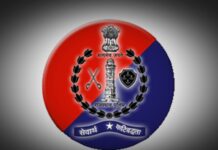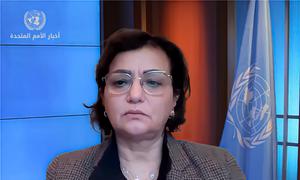
She has been into fishing-related work for the last 33 years. Earlier, she used to fish in Dal Lake along with her husband. “We could easily get up to 15 kg of fish a decade ago. Those days the lake was clean too. After my husband fell ill in 2015, I could not find time to fish. So, I buy from the locals and sell it in the market,” she says.
Jameela is worried about her three daughters, two of them are graduates and of marriageable ages. “This daily routine has sustained our family for long. In fact, it has improved our financial condition. But over the last decade, it has become increasingly difficult to make ends meet,” she laments.
“I wish I could revisit those days when I would go with my parents to catch and sell fish,” adds Jameela, who sells sattar, gad, khont, chirruh and chush varieties of snow trouts for Rs 300 to 400 on average, earning around Rs 2,000 daily.
A floating garbage dump
Mostly settled in Anantnag, Kulgam, Shopian and Pulwama districts, the Hanji community has been grappling with the negative impact of increased pollution in South Kashmir’s water bodies.
“Up until a few years ago, you could directly drink from any river or pond in villages, but now they are heavily polluted. Wastewater from residential and commercial areas goes straight into them. From plastic waste to human excreta, everything is present,” says Ali Mohammed Dar (53) from Gaad Hanjipora in Anantnag district.
“I have seen this change happen right in front of my eyes. Be it the Lidder, Ramshoo or Veshaw, I have fished from all of them. Now we net more garbage than fish. Segregating the slim catch from the garbage is an additional task – a waste of our time and effort.”
Abdul Salam Dar (57) of the same area remembers how fishermen used to throw away unsold fish as large quantities were caught around a decade ago. “The catch has dwindled, and many varieties have disappeared,” he says, citing examples of ram gurun and anood.
“Now, a good day is when we are able to catch any fish… because there are days when we do not get a single one. In today’s world, earning Rs 500 to 600 per day means nothing. That is why we are forced to become masons, plumbers or daily wage labourers.”
Choked lifelines
According to the first census of water bodies released on April 24 by the Department of Water Resources, Ministry of Jal Shakti, Jammu and Kashmir has 9,765 water bodies, but 2,272 (23 per cent) of them are not in use. Drying up, construction, salinity and industrial effluents are among the top reasons why they have fallen into disuse.
Researcher, author and social entrepreneur Rao Farman Ali says littering, untreated sewage disposal, illegal sand mining, heavy encroachment and lack of regular desilting have drastically reduced the fish population in water bodies in South Kashmir, including the Lidder, Arpath, Brengi, Sandran, Veshaw and Rambi Ara.
“Locally known as gaadi gum, the places where fish populations once concentrated have disappeared or have been disturbed by heavily mechanised sand extraction and disposal of household polythene waste,” he explains.
Ali Mohammed Dar (53) says people have reclaimed many small water bodies and have converted them into commercial or residential plots. As a result, sars, the traditional water bodies, and ponds and springs have disappeared in Anantnag and Kulgam.
Diminishing space in society
There are several sub-castes in the community, including Gad Hanz (those into fishing) Gari Hanz (water chestnut collectors), Demb Hanz (vegetable growers), Dunga and Shikara Hanz (owners of passenger boats), and Houseboat Hanz (owners of luxury houseboats).
“Our lives are interwoven with water and fishing. On April 15 every year, Aadar village sees festivities in honour of Sufi saint Saed Sahb. Fish is the main course during the festival, where tehri (flavoured savoury rice) is served to all,” Aashiq Hussain Khuroo of Guree Khushpora in Anantnag district tells 101Reporters.
“We are poorer than poor now. We do not have enough money to teach or feed our children. At times, we have to push our children into odd jobs just to make some extra money,” says Khuroo.
“Almost 70 families of the Hanji community live in our village. Very few children have passed Class 10. Some manage to study till Class 8. Others drop out before they reach Class 8, so that they can work as labourers. It is a vicious cycle.”
Fahmeeda Akhter wished to educate her children, but low income proved a bane. Her children managed to study only up to Class 8. “The only benefit that I get is Rs 3,000 once in a year under the Pradhan Mantri Matsya Sampada Yojana [PMMSY],” she says.
She adds that most of the community members have no idea about which schemes could benefit them. “Does the government not have the responsibility to make us aware of the schemes?”
There are other problems too. “Most women in our community are anaemic, especially adolescent girls. Polluted water sometimes causes skin infections,” Fahmeeda adds.
Not forgotten, says government
There are 23 hamlets with 7,000 Hanji community members in Anantnag district. As per official data, the fisheries department has issued professional fishing licences to over 1,000 of them till March.
“Our department issues licences to community members aged above 18 years. It will help them fish in reserve areas of the district and will provide an accidental health cover of up to Rs 5 lakh per family. The licences should be renewed every year for a fee of Rs 500,” Mohd Sideeq, Deputy Director of Fisheries, Anantnag, tells 101Reporters.
“Under the PMMSY, fishermen can avail of Rs 3,000 per annum, while the government also provides low-cost housing assistance of Rs 1.30 lakh under the scheme to build a house with two rooms and a toilet,” he says, adding that about 400 families have made use of the scheme so far.
Acknowledging that plastic pollution has affected aquatic flora and fauna, Sideeq says the department is making every possible effort to curb the menace. “Sand extraction has changed the topography of water bodies. Excessive use of pesticides, herbicides and insecticides has altered the physicochemical parameters of water and rendered it harmful to aquatic life. The discharge of domestic and municipal sewage has subjected the water bodies to eutrophication,” he explains.
The issues that the Hanji community faces today can be resolved only through concerted efforts. “We have a tough challenge ahead. I do not want my children to take up this profession,” Jameela says categorically.
(Sameer Ahmad is a South Kashmir-based freelance journalist and a member of 101Reporters, a pan India network of grassroots reporters)
–IANS<br>sameer/dpb<br>






























